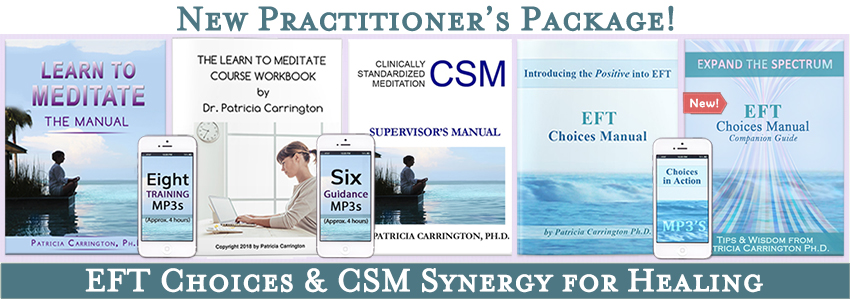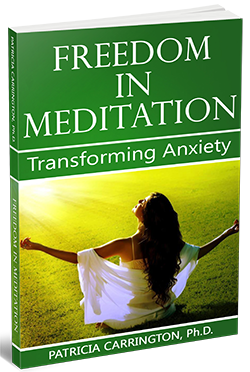
Tips for Success in Meditating
Patricia Carrington, Ph.D.
Author of “Freedom in Meditation“
When meditation is practiced on a regular daily basis, this usually results in certain advantages for the meditator. Evidence suggests that it is the person who rarely misses having at least one full meditation per day who reaps the most benefits in the long run. But what about in the short-run? Can the selective use of meditation during times of momentary stress be useful?
Various schools of meditation differ on the answer to this question, but if we ask meditators themselves, we find that most of them have at one time or another tried meditating at some specific moment to overcome a particular difficulty, and they report that meditation is surprisingly effective for such purposes.
Since there had not been any systematic studies conducted on what might be called the ‘strategic’ use of meditation at the time of our research, we considered reports from meditators who invented personal ways of using meditation to help them through life crises, large and small. There are, by now, enough of these reports to provide us with useful information.
Many meditators to whom I taught CSM reported that they effectively used very brief meditations at strategic points during the day. These meditative experiences may not have been more than a minute or two in length, so I termed them ‘mini-meditations’. One of my clients, who worked under extreme pressure at her job reported that she repeated her mantra, silently to herself, for a minute or so during work whenever her job became particularly tense. This caused an ‘immense calm’ to descend over her and she then felt balanced.
I frequently used mini-meditations, and the use of them at the New York Telephone Company’s extensive stress management program is described in detail in Chapter 18 of Freedom in Meditation. Mini-meditations are part of the standard CSM instructions, and a significant portion of the Learn to Meditate recordings are devoted to their strategic use.
Mini-meditations can also be useful to increase the effectiveness of one’s regular meditations. A meditator who suffers from hypertension reported that his two scheduled meditations of the day, though very relaxing for him, had nevertheless been unable to hold in check an extreme buildup of tension during working hours. When faced with decisions at the office, he would feel his blood pressure rising to a high pitch and could do nothing about it.
Eventually, he discovered that the undesirable rise in tension could be reversed by taking time out to meditate for five minutes whenever he recognized that he was heading into trouble. These mini-meditations, scattered throughout his day, took the edge off his tension buildups and made a marked difference in his ability to handle the stress of work with a relaxed attitude. He describes this strategy as “worth more than any tranquilizer I have ever known.” It might be valuable for any meditator suffering from high blood pressure to try this method. The Learn to Meditate Course gives a complete program for combating high blood pressure, which is based on the use of mini-meditations. By using mini-meditations in addition to regular meditation sessions, the effectiveness of meditation for combating hypertension can be substantially increased.
Meditations under highly stressful circumstances are usually mini-meditations. The nature of a threatening situation demands that we keep our attention focused on the external world, which means that deep and prolonged meditation is out of the question. This is also why many people will keep their eyes either fully or partially open during a mini-meditation. When we feel ourselves facing a threat of any kind, we instinctively glance around us and keep a sharp watch over our environment. Closing our eyes when we feel threatened may make us more anxious because it gives us a feeling of being unprotected and vulnerable.
Other relaxation techniques can also be used strategically. A young singer who had studied autogenic training is reported to have discovered by chance that during her relaxation exercises she could sing very fine, high notes which she had not been able to achieve otherwise. She decided to try inducing a state of relaxation during her singing practice, and found she could do so by repeating only one portion of her relaxation formula. Eventually this young woman was able to master alto passages when singing in actual stage performances by thinking this formula just before she commenced the aria.1
Relaxation literature also tells of an eleven-year-old boy, failing badly in his class work, who was encouraged to practice his autogenic relaxation exercises for several minutes between classes. Each time after he did so, he felt refreshed and it was easier for him to participate in class work during the following hour.2
In another instance, a golfer who had noticed after eight weeks of autogenic training that his swing had definitely improved decided to try to increase his efficiency even more by repeating part of his relaxation formula to himself just before hitting the ball. When he did this the relaxation exercise dissolved disturbing tensions in his shoulders and added to the precision of his golf technique.3
Another important potential use for strategic meditation is in preparing for surgery. Meditation has been used successfully to lower the anxiety experienced by patients preparing for cardiac surgery4 and for ambulatory surgery.5
I had used mini-meditations prior to dental surgery and know several other people who have done so. The period of waiting in the office before being escorted to the dental chair affords a good opportunity to apply strategic mini-meditations unobtrusively. When I did this, it calmed me immensely and I was much better prepared for the dentistry work.
On one occasion, I followed this preparatory meditation during the time the dentist was actually working on my teeth. Since this was a stressful situation, I kept my eyes open, and during the prolonged (hour-and- a-half) dental session, I allowed mini-meditations to come and go naturally. This was the most relaxing dental session I had ever experienced and it was surprisingly pain-free.
Learn about Clinically Standardized Meditation
A Gentle, Easy-to-Learn, Form of Meditation
Dr. Patricia Carrington’s Clinically Standardized Meditation (CSM) is a clinically sensitive meditation method used by numerous medical institutions, organizations, and individuals worldwide.
The main advantages of CSM (and also its difference to other forms of techniques of meditation) are its simplicity, its flexibility and its sensitivity to the individual needs and inclinations of the people who learn it. CSM is extremely permissive, which makes it easier to personalize and internalize the technique and its experience.
1. J. H. Schultz and W. Luthe, Autogenic Therapy, 6 vols (New York: Grune, 1969), vol. III, p. 154.
2. Ibid, p. 158.
3. Ibid, p. 172.
4. J. Leserman, E. M. Stuart, M. E. Mamish and H. Benson, ‘The Efficacy of the Relaxation Response in Preparing for Cardiac Surgery’, Behavioral Medicine, 15 (3) (1989), pp. 111–17.
5. A. D. Domar, J. M. Noe and H. Benson, ‘The Preoperative Use of the Relaxation Response with Ambulatory Surgery Patients’, Journal of Human Stress, 13 (3) (1987), pp. 101–7.








